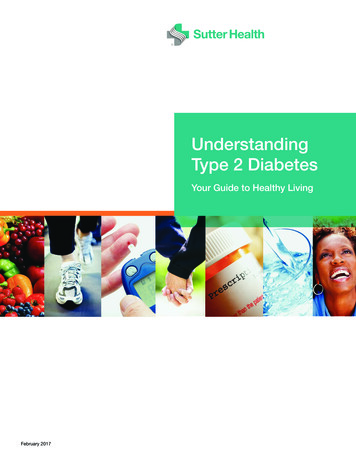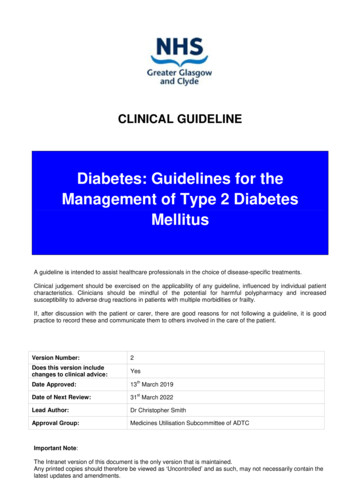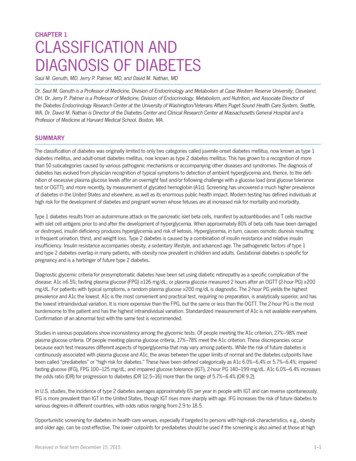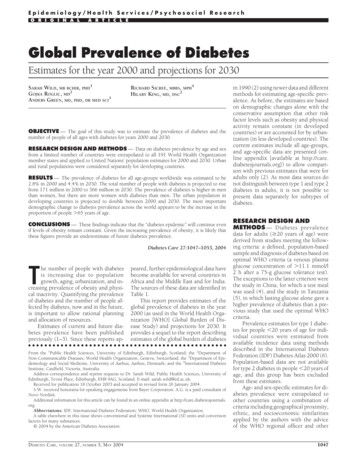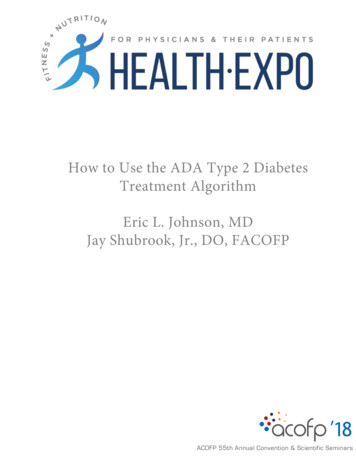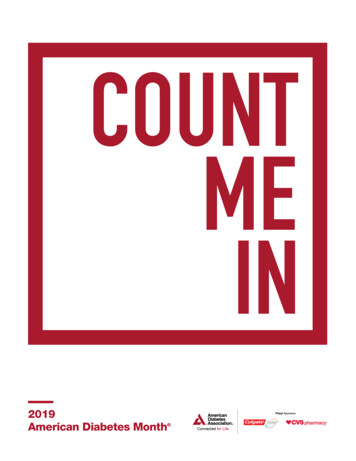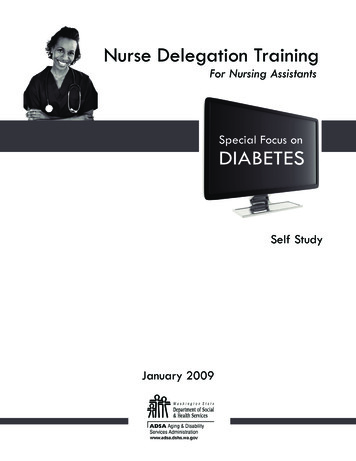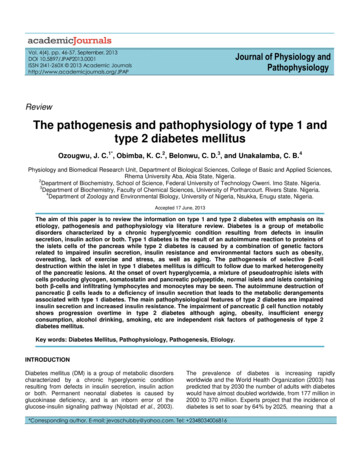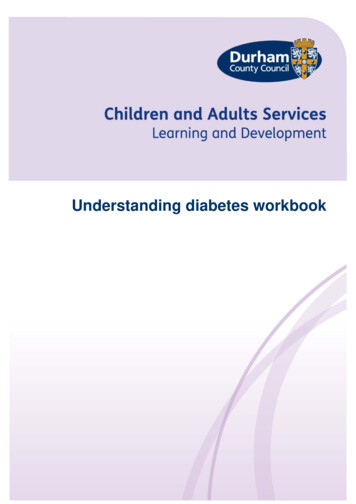
Transcription
Designed front page to insertUnderstanding diabetes workbook
ContentsGuidance on how to complete this workbook4Aims and learning outcomes5Understanding diabetesWhat is diabetes?6Common signs and symptoms7Types of diabetes9Causes of diabetes11Aims of treatment11Treatment12Dietary information14Complications of diabetes17Preventative measures21Is treatment working?23Role of carer24Dealing with emergencies25Diabetes national service framework26Care planning in diabetes27Further information27Exercises29Links to NVQ in Health and Social Care31References323
Guidance on how to completethis workbookThis booklet has been developed specifically for those members ofstaff who will be working with service users who have beendiagnosed with diabetes; however it may also be used to increaseyour general knowledge within this specific area.If you require any advice or feel you need to discuss the content orany of the workbook exercises, please speak to your line manager.It is expected that this workbook will take approximately 2 hours tocomplete.The workbook includes information, and opportunities forreflection. There are some exercises at the end of the workbook toensure learning has taken place. Upon completion of theworkbook, the confirmation page at the back must be signed byyou and your manager, and sent to the Learning and DevelopmentTeam, Adults Wellbeing and Health, County Hall, Durham.- This sign can be seen throughout the workbook and indicatesimportant information for you to consider- This sign can be seen throughout the workbook and indicates that youneed to consider ideas / provides an opportunity for reflection4
Aims and expected LearningOutcomesThe aim of this workbook is to provide: An understanding of the term “diabetes” A basic holistic understanding of some effects diabetes has upon dailyactivitiesLearning outcomes: upon completion of this workbook you should: Understand the term diabetes Recognise the common signs and symptoms of diabetes Be aware of the different types of diabetes Be aware of the aims of treatment Recognise some complications associated with diabetes Know and understand the limitations within your job role5
Understanding diabetesWhat is Diabetes?Diabetes Mellitus is a lifelong condition, characterised by thebody’s inability to control blood glucose levels within therecognised normal range.Although there is currently no definite cure for diabetes, there aremany treatment options available to safely manage thecondition.Diabetes can occur at any age. When someone has diabetes, thiscan increase the risk of developing other conditions, such as heartdisease. When it is effectively managed, people with diabetes canlead an active, healthy life, and can reduce the risk of seriouscomplications and significantly improve the quality of a person’slife.According to the NHS Choices website over 2 million people inEngland are living with diabetes; with many undiagnosed cases.Diabetes UK report that since 1996 the number of peoplediagnosed with diabetes has increased from 1.4 million to 2.9million. By 2025 it is estimated that five million people will havediabetes. It is estimated that most of these cases will be Type 2diabetes, because of our ageing population and rapidly risingnumbers of overweight and obese people.6
In 2009, around five per cent of total NHS spending was used forthe care of people with diabetes. According to NHS Choices, a UKstudy reported that the annual NHS cost of the direct treatment ofdiabetes in the UK will increase from 9.8 billion in 2012, to 16.9billion over the next 25 years. The predicted rise would equate tothe NHS spending 17% of its entire budget on the condition, upfrom about the current 10%Common signs and symptomsThe symptoms of all types of diabetes are very similar; howevertype 1 diabetes usually develops very suddenly. Generalsymptoms for diabetes include;TirednessAs glucose is unable to move from the bloodstream into the cells of the muscle and brain,energy supplies are in short supply resulting inlethargy and tirednessFrequent urinationAs the blood passes through the kidneys, glucose is filtered outinto the urine (glycosuria). During this process a lot of fluid is alsofiltered out of the body resulting in the person passing largequantities of urine, which is known as Polyuria.7
ThirstyHigh amounts of glucose in the urine can cause increased urineoutput and lead to dehydration. This causes increased thirst andwater consumption.Weight lossIn severe cases insulin deficiency eventuallyleads to weight loss and muscle wastage.ThrushUrine which contains lots of glucose creates an environment forbacteria to thrive, often resulting in thrush.Blurred visionGlucose can build up in the lens at the front of the eye altering itsshape which may result in blurred vision.Slow healing woundsBlood contains high levels of glucose therefore bacteria can breedin flesh wounds making them slow to heal.Frequent reoccurring infectionsGlucose is attracted to protein and sticks to it. The white bloodcells that fight infections are made of protein and therefore if theblood glucose levels are raised the glucose attaches itself to thewhite blood cells and slows their action, making them less effectiveat fighting infection.8
All of the above symptoms are signs that the body is not able tobalance its glucose levels. However it is also important toremember that these symptoms may be due to otherconditions.If a person you are caring for shows any of the above symptomsthat are listed it is important to encourage the individual to seekprofessional medical guidance from a general practitionerwho may arrange for urine and blood tests to be carried out,in order to provide a correct diagnosis.Early diagnosis reduces the risk of developing complications. If leftundiagnosed, diabetes can lead to eye disease, kidney diseaseand heart disease.Consider what actions you would take if you noticed that aservice user you care for was showing a number of the abovesymptoms9
Types of DiabetesThere are several different types of diabetes, for the purpose ofthis workbook we have concentrated on the commonest and mostfrequently seen.Type 1 DiabetesThis occurs when the body is unable to produce any insulin at all.Insulin is a hormone released by the pancreas to help controllevels of glucose in the blood. When no insulin is produced, this isdue to the insulin producing cells of the pancreas being destroyed.Although it can occur at any age, this normally develops in peopleunder the age of 40People with type 1 diabetes needinjections of insulin every day andalso need to eat a healthy diet.Insulin is vital to maintain life andhas a major role in the managementof diabetes. Insulin can be given byeither a syringe, insulin pen or insulin pump. The most commoninsulin regimens are two injections a day of mixed insulin or fourinjections a day (three fast acting and one long acting insulin). Thisdoes vary from person to person. If a service user with diabetes isunable to self inject then a district nurse may do this. You shouldnever inject insulin for a service user.Staff need to be extra vigilant when service users are usingneedles, in order to avoid needle stick injuries.10
As well as using insulin injections this condition can be managedwith diet and physical activities. Remember, each person isdifferent, and you will need to refer to individual care plans forguidance.Type 2 DiabetesThis occurs when the pancreas does not produce sufficient insulinto control the blood glucose levels, or when the insulin that isproduced by the pancreas is not used properly. It is the mostcommon type of diabetes, and according to NHS Choices, itaccounts for around 90% of cases.The symptoms of type 2 diabetes usually develop slowly and manypeople live undiagnosed for several months or years withoutknowing they have the condition. Unfortunately by the time theyare diagnosed many people have diabetic complications.Some people wrongly describe type 2 diabetes as the mild form ofdiabetes. This is not true. There is no such thing as mild diabetes.People with type 2 diabetes may be treated with: Diet and exercise Tablets Insulin injections Weight loss injections known as GLP1’sGestational DiabetesSome pregnant women have high levels of glucose in their bloodbecause their bodies do not produce enough insulin to meet theextra demands of pregnancy.11
Between 2% and 12% of pregnant women develop diabetes duringpregnancy. It usually disappears oncethe baby is born.Women with gestational diabetes aremore at risk of developing type 2diabetes later in life.According to NHS Choices website you are more likely to developtype 2 diabetes if you have a relative with this condition, if you areoverweight or obese, if you take little physical exercise, or are overthe age of 40.Why is it important to know what type of diabetes someone has?Causes of diabetesThere are a number of possible causes fordiabetes including: Drug related; particularly long term orhigh doses of steroids Pancreatic disease, Inflammation,cancer and surgery12
Endocrine system disease, Cushing’s syndrome Auto immune disease Lifestyle factorsAims of treatmentOnce someone is diagnosed with diabetes it is important that theyreceive sufficient support and information about the condition inorder to understand how it can be managed. Self management isessential. This means that an individual takes control of what theyeat, having a healthy diet as well as physical activity.The first aim should be to relieve the symptoms. As the glucoselevel falls the symptoms will decrease.It is important to try and achieve a near normal blood glucoselevel. The target range should be 4-7 mmol/l before meals and9mmol/l or less 2hours after meals; however some individuals’blood glucose ranges will vary. This is meant to be a guide so thatyou know what is ‘normal’. It is therefore essential that you refer toindividual care plans and where necessary keep accurate recordsof blood glucose levels.Where needed, the individual healthcare professional willrecommend times to check blood glucose levels in order to identifyat what points in the day the service users blood glucose levels arerising and falling.13
In order to reduce the risk of short term complications, and avoidhigh (hyperglycaemia) or low (hypoglycaemia) glucose levels inthe blood, carers need to be aware of the symptoms, treatmentand prevention of this condition.Having control of diabetes can reduce the risk of diabeticcomplications i.e. eyes (retinopathy), kidneys (nephropathy),nerves (neuropathy) and heart/major organs (cardiovasculardisease).It is important for people with diabetes to have regular check upsto ensure the diabetes is under control. This should include regularfoot and eye checks. The service users Doctor/nurse will advise onhow regular these checks should be.People with diabetes should aim toachieve a near normal bloodpressure. Although the target rangefor blood pressure is to be less than140/80 individual ranges will vary.It is also important to improve generalhealth and well-being. The importanceof following the suggested treatment plan, monitoring the diabetesand following a healthy lifestyle can improve health and well being.However the person with diabetes, and you as their carer, needsufficient information to do this.14
TreatmentTreatment will vary between individuals, however it ultimatelydepends upon getting the right balance of food, exercise seThere are different treatments available and these will varybetween individuals.Treatment for Type 1 diabetesWhen someone has type 1 diabetes they will need regular insulininjections, to keep their glucose levels normal. All people with Type1 diabetes require treatment with insulin therapy. Insulin for thisgroup of individuals is their lifeline. Type 1 diabetes is a lifethreatening condition without insulin therapy. Insulin therapy inpeople with Type 1 diabetes must never be stopped.Balancing insulin, diet and physical activity controls Type 1diabetes.The specific insulin used will vary from person to person and will15
depend on which insulin regimens are used. Insulin regimens useshort / rapid acting insulin to stimulate normal mealtime insulinlevels, and long acting insulin to provide a backgroundconcentration of insulin.If a person is treated with insulin, regular meals are especiallyimportant. Food should be given within specified timescales of theinsulin injection (Refer to individual assessment plans for details oftimescales). If for any reason a meal is delayed check for signsand symptoms of low blood glucose (hypoglycaemia).Treatment options for Type 2 DiabetesThe management of Type 2 Diabetes has several treatmentstages. If diagnosis has been delayed, the person with diabetesmay progress through the stages very quickly.The aim of Type 2 Diabetesmanagement is to reduce the body’sresistance to insulin and preserve theinsulin producing cells of the pancreas.Diet and physical activity are importantfactors in management of Type 2Diabetes. Losing weight, if necessaryand increasing exercise/activity will make insulin work better asthis reduces insulin resistance.The aim with this treatment option is to promote weight loss if overweight, and to reduce insulin resistance, which is linked to obesityand physical inactivity. The general recommendations in relationto physical activity are to aim for 30 minutes per day 5 days per16
week. However any physical activity is better than none, as thisimproves the body’s sensitivity to insulin.There are several different types of glucose lowering medicinesused to treat type 2 diabetes. Medication to reduce the bloodglucose level may be required if adequate control cannot beachieved or maintained with diet and exercise alone.In some cases of type 2 diabetes, it may also be necessary to treatthe condition by insulin therapy (injection).Insulin is required at the stage where failure of the insulinproducing cells become so severe that the individual is unable toproduce sufficient insulin.Dietary informationWhat a person eats affects their diabetes. Choosing a healthy diethelps to control blood glucose levels.It is important that a person with diabetes eats a normal balanceddiet with a wide variety of different foods. The preferred dietrecommended in diabetes is one, is high in fibre rich, starchy foods(such as cereals, fruit, potato, rice, pasta, beans, peas andvegetables) and low in fat, salt and sugar.17
Regular meals of starchy foodshelpto maintain a balanced bloodglucose level. For thoseindividuals on certain medication,missing meals or snacks, or noteating the starchy part of the meal may lead to too low bloodsugar.It is suggested that people who need assistance to monitor theirfood intake are given the appropriate help to do so. If this isrelevant to any of the service users you are supporting, you willneed to discuss this with your line manager.If the starchy part of the meal or a snack is missed, an alternativeshould be offered as soon as possible to prevent a hypoglycaemicattack. If a person is having regular hypoglycaemic attacks aDoctor and dietician should be contacted for further advice.How to eat more fibre Have more fruit based desserts andsnacks; e.g. crumbles made withoat flakes Encourage a whole grain and highfibre breakfast cereal such as porridge or bran flakes, and18
wholegrain breadIt is recommended to have at least 6-8 medium cups of fluid inorder to prevent bowel problems; this could include water, tea,coffee, and sugar free squash.Solid foods, especially fruit and vegetables are another essentialsource of fluid. It is also important to note that more fluid may beneeded when carrying out physical activity or during hot weather.Adding sugar to food and drinks should be avoided. The aim is toreduce foods high in sugar, this can be achieved by: Use of artificial sweeteners instead of sugars Diet or sugar free fizzy drinks Low sugar or reduced sugar jams Diet yoghurts instead of low fat yoghurts which are high insugarIt is also important to remember that some food such as fruitcontain natural sugars. Therefore it is important to monitor eachindividual and their dietary requirements.It is advised that people with diabetes eat less fried and fatty foods Encourage fruit based desserts and snacks Encourage low fat snacks Use less butter or margarine Eat fewer crisps, meat pies, pastries, biscuits and fried foods Use skimmed or semi-skimmed milk in drinks, in cooking and19
on cereals. Eat oily fish containing omega 3 at twice a week (not fried)Reduce the amount of salt, for example do not use salt whencooking and use salt sparingly on meals. It is also advisable not touse ‘lo salt’ alternatives as they may contain additives.It is recommended that any alcohol should be taken in moderation,e.g. ½ pint of beer or lager, 1 glass of wine, 1 single measure ofspirit. Please refer to individual plans for further guidance, as thiswill vary from person to person. Starchy food or a snack should beeaten if an excessive amount of alcohol is drunk in order toprevent hypoglycaemia in those on glucose lowering drugs (e.g. asandwich before bed). Remember eachindividual is different, for some people alcoholmay not be suitable at all. Always refer to careplans for details.‘Diabetic foods’ are available; however there isno need to use special ‘diabetic’ foods. Many foods sold assuitable for people with diabetes are high in fat and some productscan cause diarrhoea.Eating for a special occasion, e.g. a birthday is an opportunity tochoose something different. An occasional treat should not affectdiabetes control, if managed appropriately.Diabetes U.K. recommends that all people with diabetes shouldhave access to a state registered dietician for specific individualadvice. The dietician can also offer advice to care staff andcatering staff.20
Complications of DiabetesEarly treatment and effective management will reduce the risk ofserious diabetes complications. Not all people will developcomplications.Hypoglycaemia (Low blood glucose) is an acute situation (happensquickly) if the person with diabetes has not had enough starchyfood, too much medication, unplanned exercise or excessivealcohol.Low blood sugar is often caused by: Missed or late meals Not enough food Too much insulin or tablets More activity than usual e.g. additional exercise Too much alcohol Hot weatherSome common symptoms, which a person may experience, are: Shakes or tremor Palpitations Sweating Hunger Mood change Poor co-ordination Blurred vision21
Fast pulseRecommended treatments for hypoglycaemia are given in 2stagesFirst stage (Fast acting): glucose tablets x 3 or a small glass of Lucozade or Fizzy drink such as lemonade/coke or Fresh orange juiceSecond stage, a starchy snack (Long acting): 2 plain biscuits or A piece of fruit i.e banana or A sandwich or Next meal if this is dueIf no action is taken then the person may become confused, haveslurred speech, experience seizures and may even lapse into acoma. If they become unconscious do not give anything by mouthand ensure medical assistance is sought immediately.To prevent a hypoglycaemic attack happening the person shouldtake regular meals, correct medication, eat extra starchy food,participate in planned physical activity and moderate their alcoholintake.Hyperglycaemia (High blood glucose) occurs when the bloodglucose level rises above 11 mmols and is usually present when aperson is newly diagnosed with diabetes, poorly controlled orunwell.The signs and symptoms of hyperglycaemia and why they occurare: Excessive thirst due to the body trying to dilute the high22
concentration of glucose in the bloodFrequent passing of urine to eliminate un-required glucoselinked with thirstTiredness, due to reduced amounts of insulin which allowsglucose to be turned into energyWeight loss due to fat being broken down to produce energyInfections such as frequent occurrence of thrushSome of the causes of hyperglycaemia include: Too much food (try to eat a balanced diet) Not enough medication (ensure dosage correct) Illness (seek medical help) Not enough exercise (exercise in moderation)Some of the long term complications of diabetes:Coronary Heart Disease is much more common among peoplewith diabetes and is the main cause of death (up to 50% in Type 2diabetes). Tight diabetic control reduces the risk of CoronaryHeart Disease.People with diabetes should beencouraged to stop smoking.Stroke is more frequent in people withdiabetes, and vascular dementia is also relatively common.Neuropathy is damage to the small nerves in the feet and legscaused by high glucose levels, which eventually leads tonumbness. Normally nerves pick up all kinds of stimuli, such aspain, temperature and pressure. If the nerves become damaged,23
the person with diabetes may be unaware of these stimuli andinjuries can occur without their knowledge. The person withneuropathy may complain of a variety of symptoms including pinsand needles, burning, coldness, numbness of varying degrees orincreased sensitivity in the feet so that even the weight of thebedclothes on the feet is too much to bear. The symptoms areusually worse at night and can sometimes be relieved by pacingthe floor. Symptoms of neuropathy may be present right from theonset of the diabetes and may, in fact, be the first presentingfeature. Any person experiencing symptoms like these, but who isnot known to have diabetes should be checked for the condition.Retinopathy occurs when degenerative changes take place in theretinal blood vessels, leading to loss of vision. Retinopathy can betreated by laser therapy. Diabetes is the leading cause ofblindness in the working population. All individuals with diabetesshould have their eyes examined for evidence of diabeticretinopathy every year. This is not done as part of the routine eyecheck at the opticians.Nephropathy is disease of the kidney. Raised blood pressureaccelerates the development of nephropathy (test for protein in theurine).Renal disease is more common in individuals with Type 1 diabeteswith 20% - 40% of these developing some degree of renal failure.Diabetic nephropathy accounts for 25% of the people who developend-stage renal failure each year.Erectile dysfunction (Impotence) may have physical orpsychological causes or a mixture of the two. Diabetes can cause24
damage to the blood supply to the penis and to the nerves whichcontrol an erection.Ischaemia is another condition which may occur. It refers to poorblood supply to the feet and legs. If the blood supply is notsufficient, injuries will not heal, sores may develop and the personis less likely to be able to fight infections.The ischaemic foot will be pale and may have a waxy feel to theskin. There will be little or no hair growth on the lower legs andtoes. The skin will be cold to the touch and the person maycomplain of aching in the legs, even at rest. The symptoms, likethose of neuropathy, can be worse at night and the person willoften dangle the legs out of the bed to relieve the pain.Infection is a further complication of neuropathy and ischaemia.The presence of neuropathy allows the infection to take holdbefore the person is aware of the problem due to their inability tofeel pain. If the person has ischaemia they are less likely to beable to fight the infection because of the insufficient blood supplyand the infection will spread quickly.Signs of infection in the foot are redness, heat, and inflammationwith or without discharge of pus. Don’t forget the ‘smell test’! Aninfected wound has a distinct and unpleasant odour. Any areas likethis need URGENT medical attention.A podiatrist plays an important role in caring for people withdiabetes. Every person with diabetes should see a StateRegistered Podiatrist/Chiropodist once a year. As well as being25
able to provide treatment to nails, corns and callus, the podiatristwill assess the feet and check for any signs of nerve damage orpoor blood supply. This will help to identify people most at riskfrom developing problems later on, and enable the podiatrist towork out a treatment plan for that person to prevent the risk ofcomplications.Preventative MeasuresThere are a number of Government initiatives, which aim toimprove the general health and well being of people. Five-a-day programme - introduced in order to increase theconsumption of fruit and vegetables. Sport programmes - a number of initiatives are taking placewithin leisure centres and local communities in order toencourage people to become activeHow do you think the five-a-day programme will help peoplewith diabetes?26
Other preventative actions include: Discouraging service users from walking around on barefeet, even on carpeted areas. The wearing of slippers should be avoided; the personshould be encouraged to wear a well fitting shoe. The shoeshould be long enough, broad enough and deep enough toprevent pressure on the toes and borders of the foot. Theshoe should fasten with a high lace or strap to prevent thefoot moving around inside the shoe. The use of hot water bottles and electric blankets should bediscouraged as these can cause severe burns if the feet arenumb or the blood supply is poor. Any corns or areas of hard skin on the feet should be treatedregularly by a state registered podiatrist because if itbecomes too thick, the underlying tissue can be damagedand ulcers can develop. People who are mobile should be encouraged to take atleast a few steps on a regular basis to keep the circulationgoing. People, who are able to be mobile with assistance,should be encouraged to move/turn to prevent pressuresores.27
Remember if you notice anything unusual on the feet;report it immediately in order to encourage the personto seek professional help.Daily foot Care is essential. Encourage service users to washtheir feet in warm water every day. Be careful to check thetemperature of the water carefully with a thermometer. You mustrefer to individual care plans for details of the requiredtemperature.Guidelines for bath water temperature are 37ºC - 44ºC, andshower is 37ºC – 41ºC, however this is specific to the individual.You must follow the individual’s risk assessment Encourage service users to dry well between the toes, beingcareful not to pull the toes apart too much as this can causeulcers to develop Check shoes and slippers for foreign bodies by shaking theshoe to remove loose objects; check the soles of the shoesand run your hand around the inside of the shoe to check theinner sole and upper of the leather for rough areas.Danger signsRemember that the earlier problems are identified, the moresuccessful the treatment is likely to be. The person or carer shouldbe encouraged to take a few moments to do these daily checks28
and this may be enough to prevent the person suffering seriousComplications.Check for: Swelling in the foot or part of the foot. Colour change. This includes speckles of red/brown in hardskin. This may be the first sign of an ulcer under the skin.Also look for red/blue patches on the foot; any area thatlooks unusually pale or dark; rashes or bruises should alsobe reported. Pain or throbbing in the foot. This may be due to infection,poor blood supply or injury. Sores, splits, cut on the skin or blisters. These are alwayspotential areas for bacteria to enter the foot and causeinfections. Any area of discharge from the foot of pus, blood or fluid. Corns calluses and nail problems should be attended to bythe podiatrist on a regular basis.Is treatment working?29
Monitor your service user Are they free from symptoms? Are they content? Are they losing weight? Are there any skin changes? Are they getting things mixed upmore?All people on insulin should self monitor blood glucose levels. Ingeneral terms we should aim for levels between 4 and 10 mmol/lLess than 4 mmol/l Low4 - 10 mmol/l IdealOver 10 mmol/l HighTo monitor blood glucose levels the service user should beprovided with a blood glucose meter. This is a device used toanalyse the amount of glucose from a small sample of blood,normally obtained from a finger, which is placed on a disposabletesting strip, and then inserted into the meter.There are several meters available, with different designs andfunctions. For example some meters have a large display screenwhich may be more suitable for people with poor eyesight. It isimportant to select an appropriate meter which is easy to use. Youalso need to ensure that the person using the blood glucose meterknows how to use the device correctly, and that it is in full workingorder.A venous blood test is the most accurate method for measuringblood glucose, and should be carried out every 3-6 months, or at30
least once per year. This test shows how well diabetes control hasbeen over a 3 month period. This will be carried out by a healthprofessional.Role of the carerMany people with diabetes will need some form of emotional andpsychological support to be able to tackle the challenges thispresents and to care for themselves effectively from day to day.Each person with diabetes should be treated as an individual. Thisis in-line with person centred planning. The service users wishesshould be considered and always respected. All informationregarding the person with diabetes must be confidential (unlessthe health of the individual is at risk, then you must let the personknow that you need to inform your line manager). Carers are in anideal position to monitor the person with diabetes’ general health,whilst enabling the person to carry out daily living activities.Observe physical and mental state whilst, for example moving.Remember, monitoring the service users general health andwell-being is essential. Carers must report their concerns to theirline manager immediately.It is imp
Diabetes UK report that since 1996 the number of people diagnosed with diabetes has increased from 1.4 million to 2.9 million. By 2025 it is estimated that five million people will have diabetes. It is estimated that most of these cases will be Type 2 diabetes
